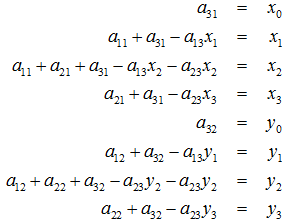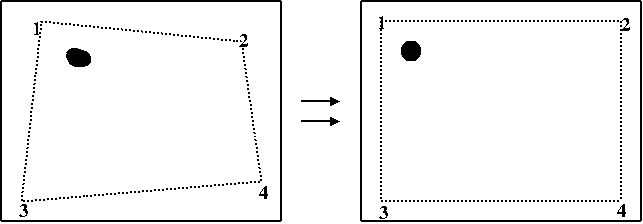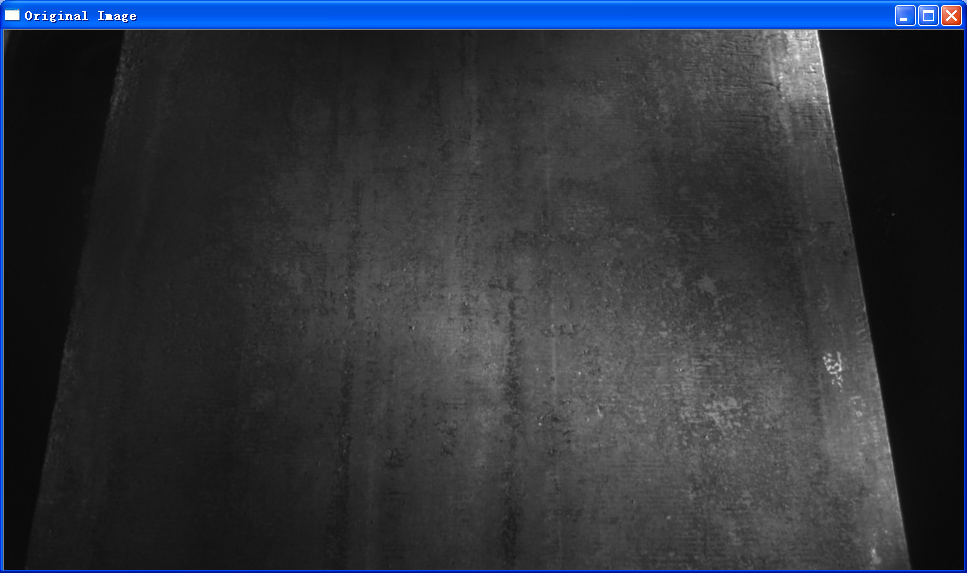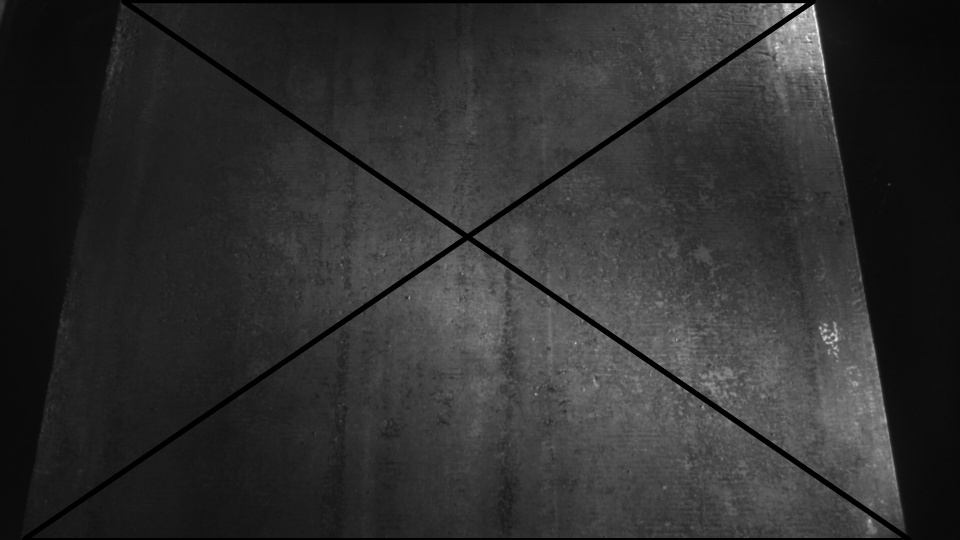opencv透视变换
实现透视变换
目标:
在这篇教程中你将学到:
1、如何进行透视变化
2、如何生存透视变换矩阵
理论:
什么是透视变换:
1、透视变换(Perspective Transformation)是将图片投影到一个新的视平面(Viewing Plane),也称作投影映射(Projective Mapping)。
2、换算公式

u,v是原始图片左边,对应得到变换后的图片坐标x,y,其中 。
。
变换矩阵 可以拆成4部分,
可以拆成4部分, 表示线性变换,比如scaling,shearing和ratotion。
表示线性变换,比如scaling,shearing和ratotion。 用于平移,
用于平移, 产生透视变换。所以可以理解成仿射等是透视变换的特殊形式。经过透视变换之后的图片通常不是平行四边形(除非映射视平面和原来平面平行的情况)。
产生透视变换。所以可以理解成仿射等是透视变换的特殊形式。经过透视变换之后的图片通常不是平行四边形(除非映射视平面和原来平面平行的情况)。
重写之前的变换公式可以得到:

所以,已知变换对应的几个点就可以求取变换公式。反之,特定的变换公式也能新的变换后的图片。简单的看一个正方形到四边形的变换:
变换的4组对应点可以表示成:
根据变换公式得到:

定义几个辅助变量:

 都为0时变换平面与原来是平行的,可以得到:
都为0时变换平面与原来是平行的,可以得到:

 不为0时,得到:
不为0时,得到:

求解出的变换矩阵就可以将一个正方形变换到四边形。反之,四边形变换到正方形也是一样的。于是,我们通过两次变换:四边形变换到正方形+正方形变换到四边形就可以将任意一个四边形变换到另一个四边形。

代码:
#include "opencv2/highgui.hpp"
#include "opencv2/imgproc.hpp"
#include <iostream>
#include <stdio.h>
using namespace cv;
using namespace std;
/** @function main */
int main( int argc, char** argv )
{
cv::Mat src= cv::imread( "test.jpg",0);
if (!src.data)
return 0;
vector<Point> not_a_rect_shape;
not_a_rect_shape.push_back(Point(122,0));
not_a_rect_shape.push_back(Point(814,0));
not_a_rect_shape.push_back(Point(22,540));
not_a_rect_shape.push_back(Point(910,540));
// For debugging purposes, draw green lines connecting those points
// and save it on disk
const Point* point = ¬_a_rect_shape[0];
int n = (int )not_a_rect_shape.size();
Mat draw = src.clone();
polylines(draw, &point, &n, 1, true, Scalar(0, 255, 0), 3, CV_AA);
imwrite( "draw.jpg", draw);
// topLeft, topRight, bottomRight, bottomLeft
cv::Point2f src_vertices[4];
src_vertices[0] = not_a_rect_shape[0];
src_vertices[1] = not_a_rect_shape[1];
src_vertices[2] = not_a_rect_shape[2];
src_vertices[3] = not_a_rect_shape[3];
Point2f dst_vertices[4];
dst_vertices[0] = Point(0, 0);
dst_vertices[1] = Point(960,0);
dst_vertices[2] = Point(0,540);
dst_vertices[3] = Point(960,540);
Mat warpMatrix = getPerspectiveTransform(src_vertices, dst_vertices);
cv::Mat rotated;
warpPerspective(src, rotated, warpMatrix, rotated.size(), INTER_LINEAR, BORDER_CONSTANT);
// Display the image
cv::namedWindow( "Original Image");
cv::imshow( "Original Image",src);
cv::namedWindow( "warp perspective");
cv::imshow( "warp perspective",rotated);
imwrite( "result.jpg",src);
cv::waitKey();
return 0;
}
#include "opencv2/imgproc.hpp"
#include <iostream>
#include <stdio.h>
using namespace cv;
using namespace std;
/** @function main */
int main( int argc, char** argv )
{
cv::Mat src= cv::imread( "test.jpg",0);
if (!src.data)
return 0;
vector<Point> not_a_rect_shape;
not_a_rect_shape.push_back(Point(122,0));
not_a_rect_shape.push_back(Point(814,0));
not_a_rect_shape.push_back(Point(22,540));
not_a_rect_shape.push_back(Point(910,540));
// For debugging purposes, draw green lines connecting those points
// and save it on disk
const Point* point = ¬_a_rect_shape[0];
int n = (int )not_a_rect_shape.size();
Mat draw = src.clone();
polylines(draw, &point, &n, 1, true, Scalar(0, 255, 0), 3, CV_AA);
imwrite( "draw.jpg", draw);
// topLeft, topRight, bottomRight, bottomLeft
cv::Point2f src_vertices[4];
src_vertices[0] = not_a_rect_shape[0];
src_vertices[1] = not_a_rect_shape[1];
src_vertices[2] = not_a_rect_shape[2];
src_vertices[3] = not_a_rect_shape[3];
Point2f dst_vertices[4];
dst_vertices[0] = Point(0, 0);
dst_vertices[1] = Point(960,0);
dst_vertices[2] = Point(0,540);
dst_vertices[3] = Point(960,540);
Mat warpMatrix = getPerspectiveTransform(src_vertices, dst_vertices);
cv::Mat rotated;
warpPerspective(src, rotated, warpMatrix, rotated.size(), INTER_LINEAR, BORDER_CONSTANT);
// Display the image
cv::namedWindow( "Original Image");
cv::imshow( "Original Image",src);
cv::namedWindow( "warp perspective");
cv::imshow( "warp perspective",rotated);
imwrite( "result.jpg",src);
cv::waitKey();
return 0;
}
代码解释:
1、获取图片,如果输入路径为空的话程序直接退出
cv::Mat src= cv::imread( "test.jpg",0);
if (!src.data)
return 0;
if (!src.data)
return 0;
2、定义边界点,输入到std::vector数据结构中。注意这里的顺序如上图。
vector<Point> not_a_rect_shape;
not_a_rect_shape.push_back(Point(122,0));
not_a_rect_shape.push_back(Point(814,0));
not_a_rect_shape.push_back(Point(22,540));
not_a_rect_shape.push_back(Point(910,540));
not_a_rect_shape.push_back(Point(122,0));
not_a_rect_shape.push_back(Point(814,0));
not_a_rect_shape.push_back(Point(22,540));
not_a_rect_shape.push_back(Point(910,540));
并将这几个点标注出来
const Point* point = ¬_a_rect_shape[0];
int n = (int )not_a_rect_shape.size();
Mat draw = src.clone();
polylines(draw, &point, &n, 1, true, Scalar(0, 255, 0), 3, CV_AA);
imwrite( "draw.jpg", draw);
int n = (int )not_a_rect_shape.size();
Mat draw = src.clone();
polylines(draw, &point, &n, 1, true, Scalar(0, 255, 0), 3, CV_AA);
imwrite( "draw.jpg", draw);
3、生成透视变换矩阵
cv::Point2f src_vertices[4];
src_vertices[0] = not_a_rect_shape[0];
src_vertices[1] = not_a_rect_shape[1];
src_vertices[2] = not_a_rect_shape[2];
src_vertices[3] = not_a_rect_shape[3];
Point2f dst_vertices[4];
dst_vertices[0] = Point(0, 0);
dst_vertices[1] = Point(960,0);
dst_vertices[2] = Point(0,540);
dst_vertices[3] = Point(960,540);
Mat warpMatrix = getPerspectiveTransform(src_vertices, dst_vertices);
src_vertices[0] = not_a_rect_shape[0];
src_vertices[1] = not_a_rect_shape[1];
src_vertices[2] = not_a_rect_shape[2];
src_vertices[3] = not_a_rect_shape[3];
Point2f dst_vertices[4];
dst_vertices[0] = Point(0, 0);
dst_vertices[1] = Point(960,0);
dst_vertices[2] = Point(0,540);
dst_vertices[3] = Point(960,540);
Mat warpMatrix = getPerspectiveTransform(src_vertices, dst_vertices);
4、执行转换
cv::Mat rotated;
warpPerspective(src, rotated, warpMatrix, rotated.size(), INTER_LINEAR, BORDER_CONSTANT);
warpPerspective(src, rotated, warpMatrix, rotated.size(), INTER_LINEAR, BORDER_CONSTANT);
5、显示并保存结果
// Display the image
cv::namedWindow( "Original Image");
cv::imshow( "Original Image",src);
cv::namedWindow( "warp perspective");
cv::imshow( "warp perspective",rotated);
imwrite( "result.jpg",src);
cv::namedWindow( "Original Image");
cv::imshow( "Original Image",src);
cv::namedWindow( "warp perspective");
cv::imshow( "warp perspective",rotated);
imwrite( "result.jpg",src);
结果:
原始图片

标注四个边界点

透视变换后的图片

需要注意的是,这里变化后的图像丢失了一些边界细节,这在具体实现的时候是需要注意的。
2017年4月30日09:03:03 感谢 网友 CHEN Tian-hua 指出一处错误,已经将 最后的a12修改成a23
